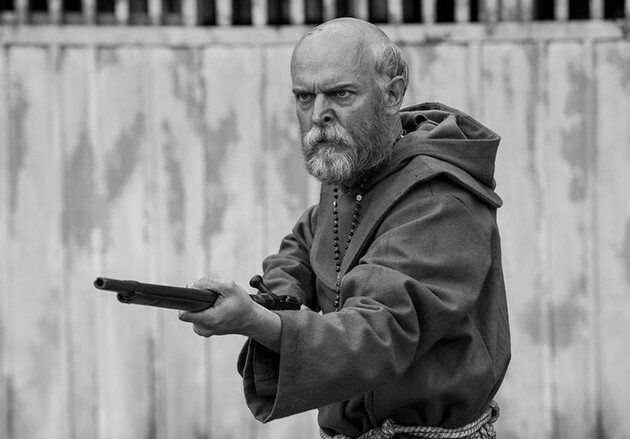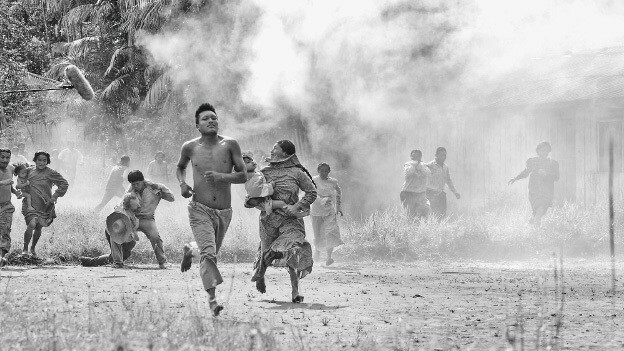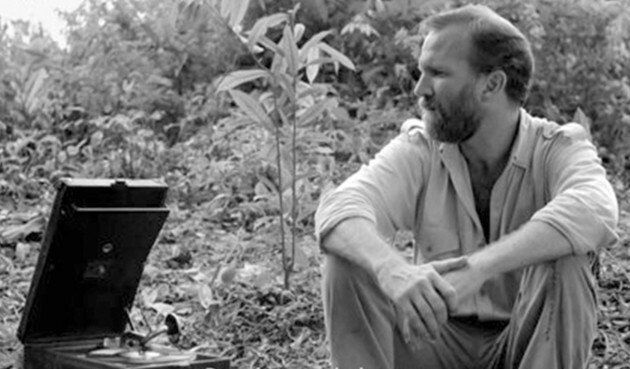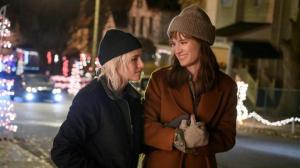Embrace of the Serpent: Analysis and Interpretation of the Film
The movie The embrace of the serpent, directed by Ciro Guerra, was presented to the public in 2015 and was nominated for an Oscar for best foreign language film. It is a Colombian, Venezuelan and Argentine co-production, shot entirely in black and white.
The film openly touches on a sensitive issue for Latin America, only from a point of view rarely approached: the encounter between cultures from the point of view of the non-Westernized native.
But it is not about the colonization of the 16th century this time, but the 20th century, a time that coincides with the invention of ethnography.
Politically and economically, the period covered in the film corresponds to the rubber fever, which had its high point between 1879 and 1912, with a brief spike in the 1940s as a result of the Second War World.
The film is inspired by the travel accounts of the German ethnographer Theodor (Theo) Koch-Grünberg and the American botanist Richard Evans (Evan) Schultes.
Summary of The embrace of the serpent

The embrace of the serpent
It is articulated from two parallel stories filmed in black and white. These stories take place in the Colombian Amazon rainforest, one in 1909 and another in the 1940s.Both stories have the same protagonist: the Karamakate shaman, a native and nomadic man who lives alone in the jungle.
The first story is co-starred by scientist Theodor (Theo) Koch-Grünberg and the second by Richard Evans (Evan) Schultes.
History of Karamakate, Theo and Manduca

The year 1909 passes. Karamakate is the last survivor of the nomadic tribe of Cohiuanos. He has inherited from his ethnic group the knowledge of the yakruna, a powerful sacred plant used for ritual and medicinal purposes.
Theo and Manduca come to meet him. Theo is a German ethnographer who suffers from a rare tropical disease and needs yakruna to heal. Manduca is a native former slave of the rubber companies of Peru, whom Theo has taken in as his traveling companion.
Karamakate is prejudiced against "white men", but as a shaman, he sees an opportunity in Theo to pass on his knowledge. Therefore, agree to help him.
Because the Cohiuana culture states that yakruna cannot be cultivated to avoid recreational use, the three of them set out on a journey in search of spontaneous shoots of the plant.
First stop: the mutilated slave and the shotgun

Manduca finds a rubber field with traces of work in progress. The memory of his trauma makes him lunge at these objects and throw them. He quickly goes out to find him a native slave mutilated by his exploiters.
Seeing the mess made by Manduca, he pleads with her to kill him. Theo travels with his objects. Among them are a shotgun and a compass. Manduca takes the shotgun and tries to kill the man, but he can't.
Although Theo is a peaceful man and only carries the shotgun for self-defense, Karamakate relives the reasons for his distrust of whites. He sees knowledge of him as knowledge for death.
For this reason, the shaman is exaggeratedly hard on Theo, whose illness gradually worsens. He also distrusts Manduca, whom he sees as a "westernized" native.
Second stop: the stolen compass
At the next stop, travelers are greeted by an ethnic group that gives them shelter for one night. As Theo leaves, he notices that his compass has been stolen.
Because attempts to retrieve her are unsuccessful, Theo can only withdraw, but he does not hesitate to express his annoyance and disapproval of what happened.
Third stop: La Chorrera Mission

As a third stop, the three men arrive at La Chorrera, a mission led by a Spanish Capuchin monk named Gaspar. Travelers stop in search of provisions.
Gaspar rescues orphaned children from rubber farms and Christianizes them. Therefore, when he sees the children listening to the "pagan" tales of Karamakate, the monk violently punishes them.
Manduca, once again, interferes and takes down the monk. As a consequence, they must leave the mission immediately.
Fourth stop: the Cohiuanos and the yakruna plantation
In the next stage of their journey, travelers meet what appear to be the last survivors of the Cohiuanos ethnic group gathered at an unoccupied border post.
It is obvious that the Cohiuanos have forgotten their culture and cultivate yakruna for their daily consumption. Karamakate is outraged at the scene.
Just at that moment, the Colombian army approaches and everyone begins to escape to save themselves from a possible attack. This time it is now up to Karamakate to relive the trauma of the genocide of his people years ago.
In a single instant, he makes two decisions: deny Theo the yakruna and burn all the sacred plant's crops.
With Theo's disappearance, the last witness of his culture disappears. Karamakate has failed and must bear the blame for having allowed him to die and for not having fulfilled his mission.
Karamakate and Evan's story
About three decades later, around 1940, the botanist Evan searches for Karamakate moved by the stories of Theo and the yakruna.
Karamakate has the opportunity to fulfill his mission and pay off the guilt that has embraced him. Thus, he sees in Evan the true witness to whom he must leave the knowledge of him.
They start the journey and go through the same places. But when they arrive at La Chorrera mission, the reality is totally different.
A self-proclaimed Brazilian messiah has taken over the place and established a cult sect around his personality, in which believers are victims of crucifixions and suicides induced.

Faced with such fanaticism, Evan and Karamakate only have to pretend to be the wise men Baltasar and Melchior to be well received. A complicity begins between them.
At the end of their journey, travelers find the last wild yakruna plant. At that moment Evan confesses his true intentions: to find good rubber for the US Army.
Despite the confession, Karamakate is convinced that Evan is the one chosen to pass on the culture to him. Placing his faith in him, he exhorts him to consume the yakruna, which induces a state of symbolic and colorful revelations, only moment of color in the film.
When he comes out of ecstasy, Karamakate is gone, but neither is Evan the same. The ending is left open for the viewer's interpretation.
Analysis of The embrace of the serpent
The film deals with four different forms of "neocolonization", whose mechanisms and conditions differ from those of the past: rubber exploitation in the Amazon, religion and sects, the violence of the national state and, last but not least, scientific discourse through the ethnography of early century.
But the director Ciro Guerra does not establish a look of victimization of the native of the Amazon. On the contrary, Guerra offers a complex perspective in which prejudices are shown from all participating points of view.
Thus, Karamakate is represented as a complex man, full of ancestral wisdom, but also affected by the limits imposed by his prejudices.

On the left side, Manduka can be seen carrying Theo, already dying.
The rubber exploitation
We do not see the exploiters, we do not see their machines. We hardly see any traces, but the whole film is traversed by the traces of the exploitation of the Amazon rainforest: the most terrible of all Western attacks on native ethnicities.
The presence of rubber exploitation is in the marks of abuse that Manduca bears on his skin, in the psychological trauma that this same character relives when he observes similar situations.
It can also be recognized in the body of the tortured and mutilated man, in the orphaned children and slaves of the Catholic mission who were rescued and finally in Evan's ambition, representing the validity of the exploitation interests western.
Four aspects of this phenomenon can be highlighted: the survival of slavery, cultural genocide, environmental destruction and greed.
Religious transformations in the 20th century
The two stories developed in the La Chorrera mission show two different aspects of religiosity.
In the first, we see the expression of a traditionalist religiosity represented by the missionary Gaspar.
The mentality of traditional religion is confronted at the beginning of the century by two phenomena, such as are the religious diversity represented by Karamakate and the scientific discourse represented by the ethnographer.
However, it will be the fanaticism of the religious sects that gives the final blow in the Amazon, a very particular form of domination and cultural alienation, as represented in the film.
The ethnographic perspective called into question

In a very clever way, the film reverses the dialectic between the Westerner (this time a "civilized" scientist), and the non-Westernized native. It will be the native who must "educate" the "white man."
Although the scientific gaze of the ethnographer supposes a recognition of the cultures studied, these studies have not managed to completely transform Theo, who still clings to his objects.
One sequence is particularly important in identifying this criticism: that of the stolen compass.
After the theft of the compass, the ethnographer explains to Karamakate that he needs the object and that, furthermore, if the tribe keeps it, he will lose his knowledge of the stars and winds.
Karamakate's response reveals by contrast the terrible prospect of the ethnographic gaze: "You can't stop them from learning... knowledge belongs to everyone, ”says the shaman. You don't understand because you're white. "
In this way, the film uncovers the scaffolding of ethnology that, at that time, was observing women. tribes as "objects" of study that should not be intervened, in order to keep them intact as a reserve cultural.
Violence: Is the West a Culture of Death?
The shaman knows that Westerners have enormous knowledge of science. But he also believes that this knowledge is used only for death, and from there comes his prejudice against Theo.
Despite Theo warning him that this is not the case, that Western knowledge also brings good and virtue, Karamakate fails to shake off his prejudice. He only understands it after suffering the guilt of letting Theo die, whose sole purpose was to find the cure for his tropical disease.

The truth is that the violence of the West is represented at different levels throughout the film, and although it is not visible, it is an agent of decision mobilization and transforms the story.
In addition to the violence of rubber exploitation, another type of violence appears: state violence national and his army, and the Second World War which, indirectly, was one of the causes of violence in the Amazon.
For the shaman, the West continues to use knowledge to kill. It is not about taking a political stance on that mid-century conflict, but about a critical look at the principle of knowledge: what is knowledge for? What is knowledge worth if it is used for death? How can such knowledge make a culture superior?
The final embrace: faith in the human
After what he learned with Theo and after what he lived with Evan, Karamakate can only make a leap of faith. Evan's confession is the key that this scientist has been touched by Karamakate's relationship.
Thus, the yakruna plant is the element that finally enshrines in the film the relationship between these two strangers, these two "other things" who had never recognized or accepted each other.
Fun Facts About The embrace of the serpent
- For the elaboration of the costumes they had to request the assistance of women of different indigenous ethnic groups.
- The embrace of the serpent It is the first Colombian film to be nominated for the Oscars.
- Ten languages are used throughout the film: Cubeo, Uitoto, Tikuna, Guanano, English, Spanish, Portuguese, German, Catalan, and Latin.
- At the beginning of filming, the use of signs was necessary since Jan Bijovet did not know how to speak Spanish.
- Before filming began, the entire team performed protection rituals with the tribes.
About Ciro Guerra
 Ciro Guerra is a Colombian filmmaker born in the César department in 1981.
Ciro Guerra is a Colombian filmmaker born in the César department in 1981.
He studied film and television at the National University of Colombia. He has made different films and short films since the beginning of his career.
In addition to The embrace of the serpent, he has directed the films: The Wayfarer's Shadow (2004), Wind travel (2009), Royal Building (2013) and Summer birds (2018).
His films have participated in festivals around the world, such as Cannes, Tribeca, Seoul, Bangkok, Seattle, Rio de Janeiro and Guadalajara.
You can see the trailer at the following link:



